Australian Kangaroos, Wallabies
|
|
FAMILY : Kangaroos and Wallabies
|
Bennett's Tree-kangaroo
(Dendrolagus bennettianus) |
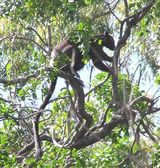
|
Bennett's Tree-kangaroo is mostly dark brown above and lighter brown on the chin, throat and underside. The top of their head and shoulders is reddish brown The forehead and snout are grey. The feet are black. The tail is black near the base and is... Click to continue> |
|
Goodfellow's Tree-kangaroo
(Dendrolagus goodfellowi) |
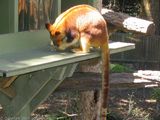
|
Goodfellow's Tree-kangaroos have short, woolly chestnut brown fur, with pale belly. Their neck, cheeks, and feet are yellow. The face is greyish-brown, with a double golden stripe running down their back. Tree-kangaroos have long, strong forelimbs... Click to continue> |
|
Lumholtz's Tree-kangaroo
(Dendrolagus lumholtzi) |
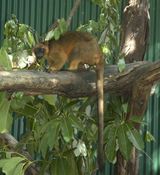
|
Lumholtz's Tree-kangaroo is a dark brown to black tree-kangaroo with light greyish brown underside. The small round head is dark brown with pale brown face and forehead. It has a large snout and small, rounded ears. The base half of the tail is... Click to continue> |
|
Agile Wallaby
(Macropus agilis) |
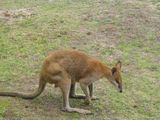
|
The Agile Wallaby is a medium sized wallaby. Light sandy brown with paler underneath. Has pale cheek stripe and light stripe on thigh. The edges of ears are black. They live in small social groups and can often seen feeding out in the open in late... Click to continue> |
|
Common Wallaroo
(Macropus robustus) |
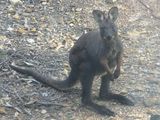
|
The Common Wallaroo is a large dark grey or reddish kangaroo with coarse fur and a black nose. The males are much larger than females.. Click to continue> |
|
Eastern Grey Kangaroo
(Macropus giganteus) |
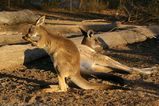
|
The Eastern Grey Kangaroo has uniform woolly grey-brown fur, slightly darker on shoulders and mid back. The tail is tipped with black Spends most of the day resting under a shady tree, only moving out to feed from dusk to dawn. Click to continue> |
|
Parma Wallaby
(Macropus parma) |
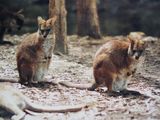
|
The Parma Wallaby has greyish brown back with white throat and chest. The conservation status of this wallaby is listed as "near threatened". They are highly susceptible to predation by foxes. Click to continue> |
|
Red Kangaroo
(Macropus rufus) |
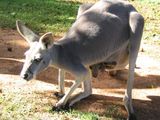
|
The Red Kangaroo (Macropus rufus), is the largest living marsupial. It is able to go without drinking as long as green grass is available, and it adapts well to drought. In some areas both males and females are red, although sometimes the female is... Click to continue> |
|
Red-necked Wallaby
(Macropus rufogriseus) |
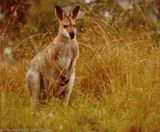
|
The Red-necked Wallaby has grey fur with reddish shoulders and upper back. There is a weak face stripe. Similar to Black-striped Wallaby, but does not have the pronounced back stripe or white hip-stripe of that species. Click to continue> |
|
Tammar Wallaby
(Macropus eugenii) |
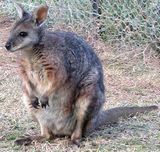
|
The Tammar Wallaby is grey brown above with reddish sides and legs. The conservation status of this wallaby is listed as "near threatened". Presently only found in a few sites of mainland Western Australia and Kangaroo Island in South Australia. Click to continue> |
|
Western Grey Kangaroo
(Macropus fuliginosus) |
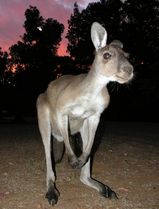
|
The Western Grey Kangaroo is greyish-brown to reddish-brown in colour. Their muzzles have finer hairs than most other kangaroo species. Dark brown face, often with a line of white outlining the lower face. Eastern greys are lighter overall with a... Click to continue> |
|
Whiptail Wallaby
(Macropus parryi) |
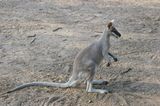
|
The Whiptail Wallaby is light grey or brownish grey, with white underneath. Dark brown forehead, with white stripe on face. Click to continue> |
|
Bridled Nailtail Wallaby
(Onychogalea fraenata) |
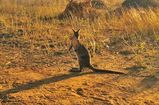
|
The Bridled Nailtail Wallaby is a pale grey-brown wallaby. It has a distinctive stripe from the neck down each side behind the forearm - the bridle marking. It has a horny pointed nail on the end of the tail. Click to continue> |
|
Allied Rock Wallaby
(Petrogale assimilis) |
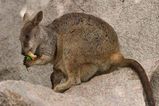
|
Click to continue> |
|
Black-footed Rock-wallaby
(Petrogale lateralis) |
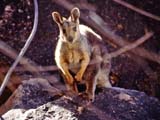
|
The Black-footed Rock-wallaby is reddish brown above with paler underside. The fur is thick and feet are dark. It has a distinct white cheek stripe. Tail is dark is brown with brush at end. Click to continue> |
|
Brush-tailed Rock-wallaby
(Petrogale penicillata) |
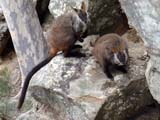
|
The Brush-tailed Rock Wallaby is brownish above, with reddish tint towards the rear. It has white cheek stripe and pale grey side stripe. Tail has brush at end. Click to continue> |
|
Mareeba Rock-wallaby
(Petrogale mareeba) |
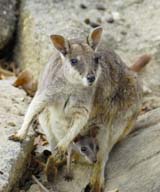
|
The Mareeba rock-wallaby varies, from almost black to grey-brown to light brown. It has lighter underparts, and side of face. The tail is usually dark brown or black at tip. The darker ones tend to live where the natural rock is darker. Click to continue> |
|
Yellow-footed Rock-wallaby
(Petrogale xanthopus) |
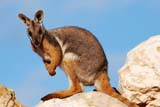
|
The Yellow-footed Rock Wallaby is grey above and white underneath. Has reddish patches on legs and white side stripe. The tail is barred - no other Wallaby has this kind of markings on the tail. Click to continue> |
|
Quokka
(Setonix brachyurus) |

|
The Quokka is a small wallaby about the size of a domestic cat. Grey-brown above. Fur is long and coarse. Very short ears. Click to continue> |
|
Red-legged Pademelon
(Thylogale stigmatica) |
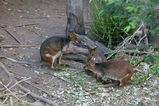
|
The Red-legged Pademelon is a small brown wallaby with rust-red legs and face Click to continue> |
|
Red-necked Pademelon
(Thylogale thetis) |
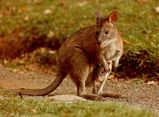
|
The Red-necked Pademelon (pronounced "paddy melon") is a small wallaby. It is brownish-grey above and pale underneath. The neck and shoulders are reddish in colour. Click to continue> |
|
Tasmanian Pademelon
(Thylogale billardierii) |
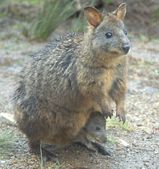
|
The Tasmanian Pademelon is a small wallaby. It is dark brown or grey-brown above, and lighter red-brown colour underneath. The fur is dense and long. Click to continue> |
|
Swamp Wallaby
(Wallabia bicolor) |
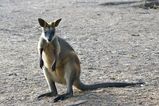
|
The Swamp Wallaby is very dark in colour with reddish orange belly. It has a dark, almost black face. The fur is coarse. A form found on South Stradbroke Island is lighter in colour. Click to continue> |
|

